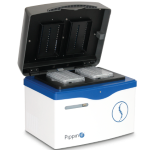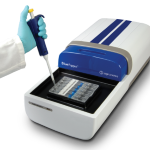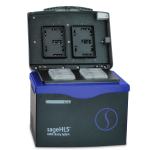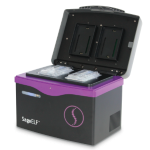Evaluating the analytical validity of circulating tumor DNA sequencing assays for precision oncology
April 2021
Authors:
Multiple authors, the SEQC2 Oncopanel Sequencing Working Group
Info:
A multi-site and cross-platform evaluation of circulating tumor DNA (ctDNA) NGS assays was conducted by the SEQC2 Oncopanel Sequencing Working Group and reported on in this comprehensive study. Five assays were tested for accuracy, sensitivity and reproducibility including simulations with spike-in DNA. This study is intended to report the state-of-the-art of these assays and inform best practices.
Pippin Prep was used to size select the ctDNA reference samples using 110 bp start and 190 bp end settings for an average fragment length of ~150 bp.
Nature Biotechnology
DOI: 10.1038/s41587-021-00857-z
Nanopore adaptive sampling: a tool for enrichment of low abundance species in metagenomic samples
May 2021
Authors:
Samuel Martin, Darren Heavens, Yuxuan Lan, Samuel Horsfield, Matthew D Clark, Richard M Leggett
Info:
Oxford Nanopore adaptive sampling is a real-time sequencing method with which analysis software identifies several hundred sequence bases as they pass through a pore and decides whether to continue sequencing. If not, the pore voltage is reversed and the associated DNA molecule is ejected. The authors suggest using this method to detect rare or non-abundant species in metagenomic studies of microbial communities. To this end, they created a synthetic mock microbial consortium with seven species, presented different proportions, and tested the method. The authors demonstrate the benefit of this approach and provide a mathematical model to test the suitability for adaptive sampling for environmental metagenomic studies.
BluePippin was used to High-Pass to size select (>15kb) the DNA from the microbial samples prior to Oxford Nanopore library construction.
Author Affiliations:
Earlham Institute, Norwich, UK
Natural History Museum, London
bioRxiv preprint
DOI: 10.1101/2021.05.07.443191
Gene by environment interaction mouse model reveals a functional role for 5-hydroxymethylcytosine in neurodevelopmental disorders
May 2021
Authors:
Ligia A. Papale, Andy Madrid, Qi Zhang, Kailei Chen, Lara Sak, Sündüz Keles, and Reid S. Alisch
Info:
Researchers studying the role of 5-Hydroxymethylcytosine (5hmC) epigenetic modifications in neurological disorders report on the effect of prenatal stress on 5hMC abundance in mice. Knockouts of the Cntnap2 gene in mice have shown disruption in 5hmC, resulting in behavioral disorders. The researchers subjected mice that were heterozygous for Cntnap2, which are behaviorally normal, to prenatal stress. As adults these mice exhibited similar abnormalities. Using NGS and ChIP-seq, the authors propose a mechanism by which 5hmC alters the binding of the transcription factor CLOCK near the promoters of several genes.
PippinHT size select ChIP libraries (~400 bp) generated by the NEBNext® ChIP-Seq Library Prep Kit.
Author Affiliations:
Department of Neurological Surgery,
Department of Statistics, Biostatistics, and Medical Informatics,
Department of Neuroscience training program, University of Wisconsin, Madison, WI
Department Mathematics and Statistics, University of New Hampshire, Durham, NH
bioRxiv preprint
DOI: 10.1101/2021.05.04.441625
Circulating miRNA diversity, origin and response to changing metabolic and reproductive states, new insights from the rainbow trout
Authors:
Emilie Cardona, Cervin Guyomar, Thomas Desvignes3, Jérôme Montfort , Samia Guendouz, John H. Postlethwait , Sandrine Skiba-Cassy, Julien Bobe
Info:
The researchers conducted a comprehensive study of circulating miRNAs (c-mRNAs) in biological fluids of the rainbow trout, with the aim of using c-miRNAs as biomarkers of reproductive and metabolic states of the fish species. The authors demonstrate strong fluid-specific miRNA signatures in plasma and ovarian fluids in particular. They identify potential biomarkers in response to high feeding rates in plasma (indicating active myogenesis) and biomarkers in response to ovulation ane egg quality in ovarian fluid.
PippinHT was used to isolate miRNA libraries (126-169 bp) from NEXTFlex small RNA kits (Perkin Elmer/Bioo Scientific).
Author Affiliations:
INRAE, LPGP, Fish Physiology and Genomics, Rennes, France
INRAE, Univ. Pau & Pays Adour, Saint-Pée-sur-Nivelle, France
Institute of Neurosciences, University of Oregon, Eugene OR
MGX, UMR, Institute of Functional Genomics, Montpellier, France
GenPhySE, University of Toulouse, INRAE, ENVT, Castanet-Tolosan, France
bioRxiv preprint
DOI: 10.1101/2021.03.09.434572
Chromosomal rearrangements but no change of genes and transposable elements repertoires in an invasive forest-pathogenic fungus
Authors:
Arthur Demené , Benoît Laurent , Sandrine Cros-Arteil , Christophe Boury , Cyril Dutech
Info:
The authors present a high-quality de novo genome assembly of Cryphonectria parasitica, and invasive fungus that causes chestnut blight, using Oxford Nanopore and Illumina sequencing. The assembly was compared to a recently published reference genome. The comparison showed little difference in gene and transposable element repertoires but showed significant chromosomal rearrangements. The authors suggest that the differences likely have implications with regard to gene regulation and mating of invasive fungi.
BluePippin was used to High-Pass size select (>20KB) using the High Pass Plus cassettes prior to library preparation for the Oxford Nanopore GridION.
Author Affiliations:
BIOGECO, INRAE, Univ. Bordeaux, Cestas France
BGPI, INRAE, CIRAD, Montpellier FRANCE.
Citation:
bioRxiv preprint
DOI: 10.1101/2021.03.09.434572





